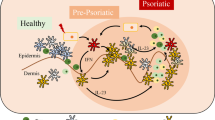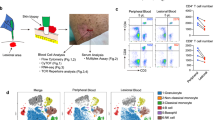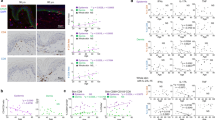Abstract
LANGERHANS'S cells from the digest of the black epidermis of the guinea-pig have been classified according to the number of processes in the cells1,2. Cells possessing five, four, three and two dendritic processes are classified as types I, II, III and IV, respectively. This communication describes a method of counting the absolute total, the differential number and percentage differential number of these cells.
This is a preview of subscription content, access via your institution
Access options
Subscribe to this journal
Receive 51 print issues and online access
$199.00 per year
only $3.90 per issue
Buy this article
- Purchase on Springer Link
- Instant access to full article PDF
Prices may be subject to local taxes which are calculated during checkout
Similar content being viewed by others
References
Shukla, R. C., Nature, 211, 885 (1966).
Shukla, R. C., Curr. Sci., 35, 151 (1966).
Medawar, P. B., Nature, 148, 783 (1941).
Shukla, R. C., Karkun, J. N., and Mukerji, B., Curr. Sci., 22, 211 (1953).
McManus, J. F. A., and Mawry, R. W., Staining Methods (Paul B. Hoeber, New York, 1960).
Billingham, R. E., and Medawar, P. B., Phil. Trans. Roy. Soc., B, 237, 151 (1953).
Shukla, R. C. (to be published).
Shukla, R. C., Zaidi, S. H., and Mukerji, B., J. Sci. Indust. Res., 18, 153 (1959).
Author information
Authors and Affiliations
Rights and permissions
About this article
Cite this article
SHUKLA, R. A Method for determining the Total and Differential Count of Langerhans's Cells in the Skin. Nature 212, 955–956 (1966). https://doi.org/10.1038/212955a0
Issue Date:
DOI: https://doi.org/10.1038/212955a0
This article is cited by
-
Die Langerhans-Zelle Ergebnisse neuerer experimenteller Untersuchungen
Archiv f�r Klinische und Experimentelle Dermatologie (1967)
-
Morphological classification of the basal melanocytes of the human skin
Experientia (1967)
Comments
By submitting a comment you agree to abide by our Terms and Community Guidelines. If you find something abusive or that does not comply with our terms or guidelines please flag it as inappropriate.



